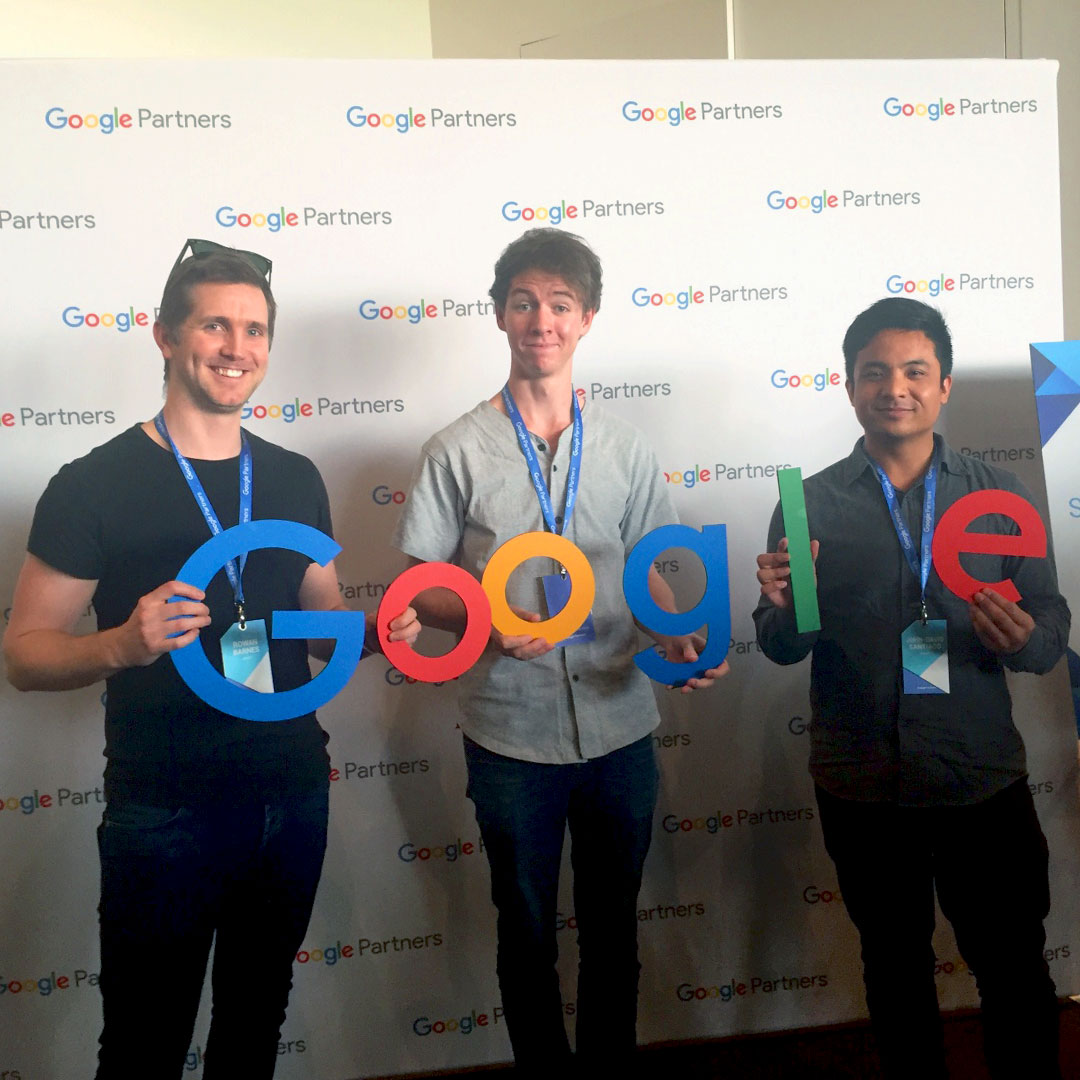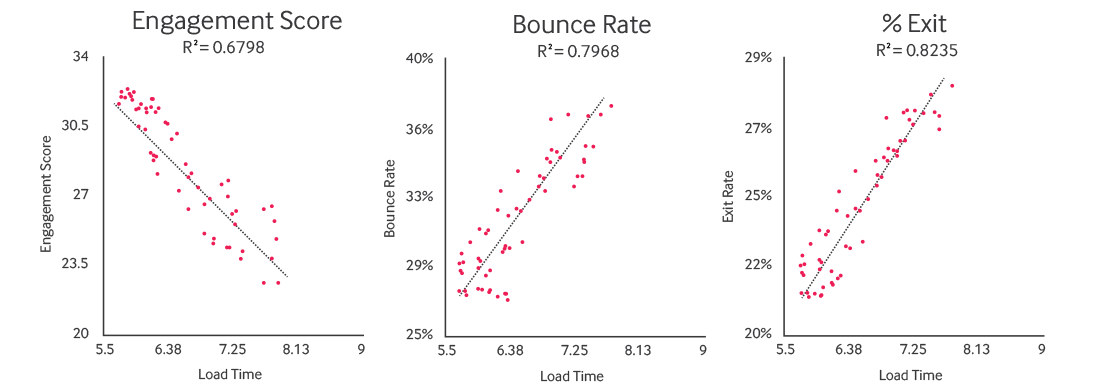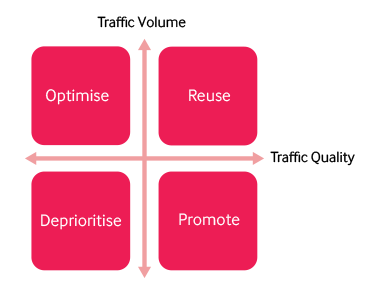- |
- |

Last month, myself and two other Augies attended the Google Partners Masterclass in Melbourne.
The event was presented by Nick Iyengar, Director of Digital Intelligence at Cardinal Path. It was packed full of helpful tips in the fields of Adwords and Analytics and topped off with some valuable insight into lessons learned at Cardinal Path over the past few years.
Here are my top 8 takeaways from the day.

The August ‘search party’ arrive at Masterclass ’16.
1. Use ‘Customer Match’ to target ads at people based on their email address.
Many of you will be familiar with Adwords remarketing. Someone comes to your site, you drop a cookie in their browser, and you can then target ads at those people. Customer Match is similar, but with a few key differences:
- Instead of dropping cookies in browsers, you supply Google with a list of email addresses.
- You can then target ads at those people in Google Search, YouTube and Gmail.
- Customer email lists don’t expire like remarketing cookies do.
I can certainly see some benefits to this feature; it’s instant, you don’t have to wait for cookies to build up, and it’s more direct — you know exactly who you are marketing to. And for those of you who think it is creepy: you’re probably right, it is a bit creepy. But if you’re comfortable using remarketing, you’ll probably be comfortable with this, too.
2. Page load time is kind of a big deal.
A true Analytics specialist, Nick didn’t just tell us ‘page load time is important’. He actually backed it up with some pretty robust data, like these graphs below:

He also provided some handy tips on using Google Analytics to look for quick wins, and provide continual improvements to page load time.
Nick’s key point? Improving speed benefits the entire business. Whether you’re in charge of SEO, a web developer, a marketing manager or even a CEO, improving page load time should be a priority. It really is a big deal.

Eliminate load times.
3. Use the GA add-on for sheets to quickly create your own visualisations.
Google Analytics is an amazing piece of software. But its visualisation capabilities are pretty limited. If you want to create your own visualisations, the Google Analytics Add-on for Google Sheets is a must.
This add-on allows you to quickly create reports based on almost any combination of dimensions and metrics from Google Analytics. From there, you can do your own analysis and create your own visualisations.
Pro-tip: When Google Data Studio is finally released in Australia — come on already Google! — you’ll be able to import data from Google Sheets directly into Google Data Studio.
4. Use a 2×2 system to categorise content.
By integrating Google Analytics and Google Search Console, it is possible to send Search Console data into Google Analytics. This gives you what Nick described as ‘pre-click’ data — search engine data such as impressions, which is collected before a user arrives at your website.
Using a 2×2 grid with ‘traffic volume’ (think: is the landing page getting lots of impressions in Google search?) on one axis and ‘traffic quality’ (think: is the landing page leading to conversions?) on the other, Nick explained how to categorise your website’s content:

- Optimise: If a piece of content is getting a high volume of traffic, but is lacking conversions, optimise that content for higher conversions.
- Deprioritise: If your content is lacking in both volume and quality, deprioritise it.
- Promote: If your content is of a high quality, but isn’t getting seen much, you need to promote it.
- Reuse: When both factors are looking good i.e. high traffic volume and high traffic quality, reuse that content. Write something similar, or repurpose that content into other formats.
5. Analyse search queries across different devices.
Sticking with the topic of Google Analytics and Search Console integration, Nick went on to describe how to analyse search queries across different devices. He also showed that by using Excel pivot tables, it is possible to identify whether there are search queries that are only being shown to users on a certain device e.g. shown on a desktop, but not on mobile.
This is pretty interesting insight, and gives you the ability to quickly find content that needs to be optimised.

Identify under-performing content and optimise it to create a perfect fit for specific contexts.
6. Use data to calculate optimal Adwords spend.
Because I’m a bit of a data nerd myself, my favourite segment of the event was Nick’s ‘Channel Mix Analysis’ presentation, where he showed us how to use data (and some Excel wizardry) to answer common client questions like:
- ‘How much revenue could we generate with a budget of X?’
- ‘What’s the optimal way to spread my budget across brands/campaigns/channels?’
- ‘Am I ‘tapped out’ on Adwords?’
It’s not enough to make gut instinct calls on these kinds of questions. Instead, back up your recommendations with hard data like the below. And look like a serious pro while you’re at it.

7. ‘Should I bid on my own brand name?’ – you can use data to answer that question.
Another interesting part of Nick’s presentation was the topic of ‘Organic Vs. PPC cannibalisation’. Or, in more simple terms, ‘If I bid on my brand name in Adwords, will I lose organic traffic that I would have received anyway?’
You may have heard of the ‘1 + 1 = 3’ effect—when you use PPC, cannibalisation doesn’t occur, and in fact creates an overall increase in click-through rate for organic listings.
But the 1 + 1 = 3 effect doesn’t always exist, so it’s important to use data to find out where this effect is in play, and where it isn’t. Luckily for us, Nick explained how to link Google Search Console with your Google Adwords account, and then use the ‘Paid Vs. Organic’ report within the Adwords interface to figure out where cannibalisation is occurring.
Once again, using data to back up recommendations, not just opinion.
8. Avoid ‘weak language’ in your SOWs.
At the end of the event, Nick changed direction and presented on some key learnings from the past couple of years at Cardinal Path. One of those key learnings was the topic of Statements of Work (SOWs), and how it is essential that they don’t contain ‘weak language’.
SOWs containing vague, ambiguous language can lead to all sorts of problems with clients. If something goes wrong with a project and the client is at fault, you don’t want to be the ones picking up the bill for all the extra work.

A stronger approach can go a long way towards a better rapport.
So, make sure your work contracts contain strong language, for example:
- Don’t say ‘deliverables may include…’. Instead, say ‘deliverables will include…’. Explicitly document what is (and isn’t) included in the service.
- Include and outline any assumptions in your SOW, along with the implications if those assumptions turn out to be true or false.
- Provide hard dates for milestones, along with a clear process for change control.
- Never start work without a signed SOW.
Change is normal, expected, and in many situations, is welcome! But it is important to ensure everyone knows what happens when something changes, and what the implications of those changes are.
***
So there you have it, 8 key takeaways from Nick’s excellent Masterclass presentation. A big thanks to Nick and the Google Partner’s team. I took a lot out of this event, and I’m definitely looking forward to the next one.
More Articles
Up for some more?
Get your monthly fix of August happenings and our curated Super8 delivered straight to your inbox.
Thanks for signing up.
Stay tuned, the next one isn't far away.
Return to the blog.